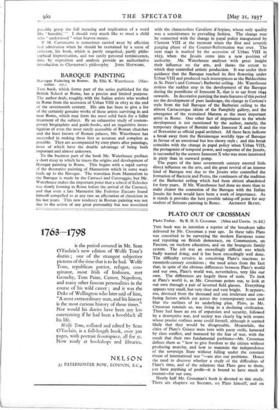BAROQUE PAINTING THIS book, which forms part of the series
published for the British School at Rome, has a precise and limited purpose. The author deals, roughly, with the Italian artists who worked in Rome from the accession of Urban VIII in 1623 to the end of the seventeenth century. His aim has been to give a list of the certainly genuine works of these artists surviving in and near Rome, which may form the most solid basis for a fuller treatment of the subject. By an exhaustive study of contem- porary biographies and guide-books, and an inquisitive inves- tigation of even the most rarely accessible of Roman churches and the least known of Roman palaces, Mr. Waterhouse has succeeded in making these lists as accurate and complete as possible. They are accompanied by sixty plates after paintings, most of which have the double advantage of being both important and almost unknown. To the business part of the book Mr. Waterhouse prefixes a short essay in which he traces the origins and development of Baroque painting in Rome. This begins with a rapid survey of the decorative painting of Mannerism which in some ways leads up to the Baroque. The transition from Mannerism to the Baroque is made by the Carracci and Caravaggio, but Mr. Waterhouse makes the important point that a school of Eclectics was slowly forming in Rome before the arrival of the Carracci, and that even a late Mannerist like Federico Zuccaro found himself compelled to at any rate an affectation of classicism in his last years. This new tendency in Roman painting was not due to the action of any great personality but was associated with the characterless Cavaliere d'Arpino, whose only quality was a sensitiveness to prevailing fashion. The change may be connected with the change in papal policy inaugurated by Clement VIII at the moment when the first and severely purging phase of the Counter-Reformation was over. The next stage is marked by the accession of Urban VIII in 1623, when the Jesuits come into a new position of authority. Mr. Waterhouse analyses with great insight their influence on the arts, and shows the extent to which they controlled artistic production. It was under their guidance that the Baroque reached its first flowering under Urban VIII and produced such masterpieces as the Baldacchino in St. Peter's and Cortona's Barberini ceiling. Mr. Waterhouse notices the sudden stop in the development of the Baroque during the pontificate of Innocent X, that is to say from 1644 onwards. In decorative painting the main features of this period are the development of pure landscape, the change in Cortona's style from the full Baroque of the Barberini ceiling to the almost Carraccesque idiom of the Pamphily gallery, and the emergence of the restrained Marotta as the most important artist in Rome. One other fact of importance to the whole development is not mentioned by the author, namely, the temporary disgrace of Bernini under Innocent X and the rise of Borromini as official papal architect. All these facts indicate a break away from the Berninesque worldly type of Baroque in favour of an emotional but less showy style ; and this break coincides with the change in papal policy when Urban VIII, the protagonist of temporal power, and supporter of the Jesuits, is succeeded by the austere Innocent .X who was more interested in piety than in outward pomp. The popes of the later seventeenth century exerted little direct influence on the arts, and the great revival of an intense kind of Baroque was due to the Jesuits who controlled the formation of Baciccia and Pozzo, the continuers of the tradition of the Barberini ceiling which had been almost abandoned for forty years. If Mr. Waterhouse had done no more than to make clearer the connexion of the Baroque with the Italian Jesuits his book would have been a work of importance. As it stands it provides the best possible taking-off point for any














































 Previous page
Previous page